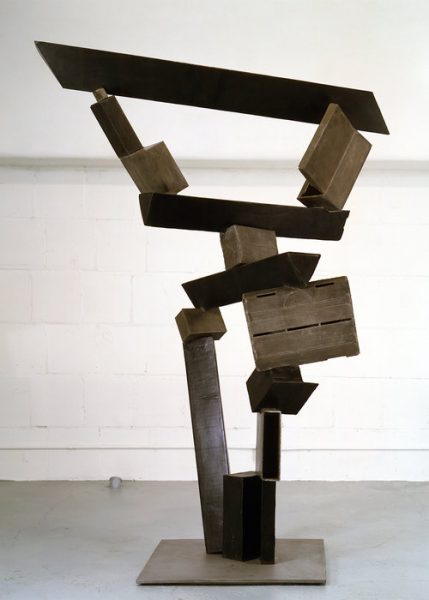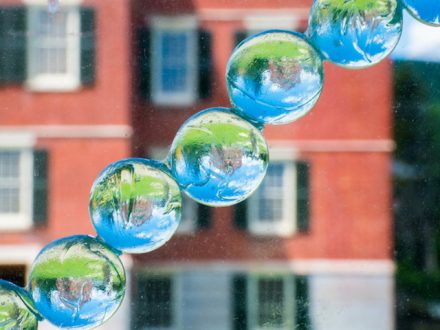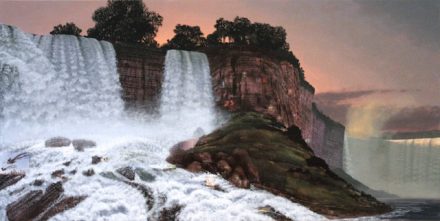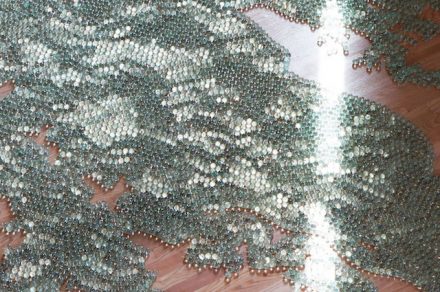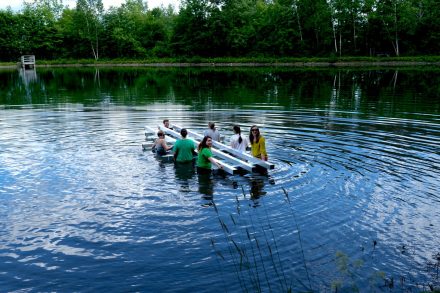(HANCOCK, Mass.) – Works by an all-star team of contemporary artists, including Gregory Crewdson, Don Gummer, Stephen Hannock, Jenny Holzer, Maya Lin, and David Teeple, go on view at Hancock Shaker Village on Saturday, July 1, in Making: Then and Now, a landmark exhibition of contemporary art that explores the connection between artists today and an historic utopian movement in the Berkshires, a place both have called home.
Making: Then and Now includes works by contemporary artists and is installed directly into the historic spaces of the historic site, including the 1878 Poultry House and the Shaker reservoir.
Exhibition Notes:
Artists are constantly involved in the fundamental “act of making.” So, too, were the Shakers. Work was a form of worship for the Shakers, and objects were made to the best of one’s ability. Artists and Shakers both create with a higher purpose in mind. Artists are striving to create something new, something tangible and beautiful or thought-provoking that adds to our cultural heritage. The Shakers were creating objects and architecture that did the same thing. The minimalist beauty of the Shakers may have been accidental, but it lives on in their material culture and continues to inspire artists and designers today.
Artists taking part in this exhibit all responded to the site and found that in experiencing a place like Hancock Shaker Village, they felt the intention of the Shakers, the community’s reverence for a thing well made. For the artists, it was something of a revelation to encounter it in a 19th -century utopian community, as few makers practice this level of quality in today’s day and age.
Contemporary artists respond to the world around them – to the Berkshire landscape that they call home or to the political landscape that it seems we cannot escape from today. They respond to the earth – a bend in the river, iron ore from its depths, its color and contrasts. They respond to the feelings that we have as humans – momentary isolation or inequality in some shape or form.
The Shakers responded to their landscape as well – they created villages within it that utilized the natural resources that surrounded them. Forests and streams were part of their world. They harnessed the streams to create green energy to run their machines, they hewed the trees from their forests to build monumental architecture. They lived isolated lives, separate from the outside world where they practiced equality for all in order to create a “heaven on earth.” The act of making and creating fulfills basic human needs – those of beauty and necessity.
“Contemporary artists and the Shakers are makers in the truest sense,” said Jennifer Trainer Thompson, who in January became president of Hancock Shaker Village after 28 years at MASS MoCA, “This is the inaugural exhibition in a contemporary art program that highlights the natural link between the Shakers and artists of today.”
While most works are displayed in the Poultry House Gallery, the boundaries of the exhibit reach beyond the walls. On the lawns outside the gallery are sculptures and fountains in metal by Don Gummer as well as work by David Teeple. Teeple will also install a temporary sculpture during the month of July in the Shaker reservoir.
Around 1818, the Shaker Brook nearby was dammed at Hancock and piped underground to form a reservoir that supplied water to the Village. Water was then conveyed from the reservoir through another underground aqueduct into the Village to power machinery, supply the laundry, water the stables, and afterward drain into distant fields to water cattle and livestock.
In 1894, the reservoir was enlarged to add two million more gallons of water. It took the work of 12 men, 6 horses and 2 yoke of oxen to cart the earth from one side of the reservoir to the other to heighten the banks. During droughts this reservoir was essential to continue the flow of water to power the belt-driven turbine in the Laundry and Machine Shop.
The Shaker brothers utilized the turbine (installed in 1859) to power their woodworking equipment, such as lathes, planers and circular saws. The sisters used the turbine to run their washing machines – another example of the gender equality that the Shakers practiced in everyday life. Restored in the 1990s, the turbine is still in use today.
About the Artists
Gregory Crewdson is a photographer and filmmaker. His photos are often elaborately staged scenes of surreal situations in American homes and neighborhoods. Series such as Beneath the Roses (2007) create cinematic images from apparently ordinary interiors. Crewdson has exhibited at venues such as the Guggenheim in New York and Bilbao, the National Gallery of Victoria in Australia, and the Museum of Contemporary Art in Tokyo, Japan. His haunting photographs are highly sought after, and have been acquired by museums including the Los Angeles County Museum of Art, CA, Museum of Modern Art, NY, and the Whitney Museum of American Art, NY.
Crewdson’s work on display explores isolation – the scene is an interior from a Berkshire county industrial building that has closed like so many others. Beautiful and unique, this one of a kind black and white Polaroid has never been exhibited, and is part of the artist’s personal collection. The image depicts one of the artist’s Beneath the Roses sets, shot on the sound stage at MASS MoCA in North Adams in 2007 and truly captures the architecture of the Berkshires.
Don Gummer works in a variety of mediums, though his monumental pieces of swirling metal may be among his most recognized sculptures. His work has been exhibited extensively in museums and galleries, public venues, and through commissioned pieces in the US and abroad. Commissioned works include Primary Compass (2000) at Butler Institute of American Art in Youngstown, Ohio, and Southern Circle (2004) at the Meridian Street Plaza in Indianapolis, IN.
At Hancock this summer, his sculptural wall reliefs explore what Gummer calls the “poetry of plans” as they juxtapose floor plans from different types of buildings to create a whole that comments on architecture in all of its forms. His Atelier Jianshu Over R.M. Schindler’s Packard Residence (2005) is a Chinese studio plan overlaid on the plan of a two-storied Schindler house. Schindler was an architect who was against ornament, and focused on “space architecture.” A more personal wall relief is Blue House Without Ghost (2004), where Gummer has laid out the most straightforward plan for his own nineteenth century guest house, proving to his wife that there is nowhere within it for ghosts to reside.
Stephen Hannock is a painter known for producing atmospheric landscape paintings that include elements of collage – pieces of text, photos and handwriting. Hannock is one of only a handful of contemporary artists selected for inclusion in the just released compendium, The Metropolitan Museum of Art, Masterpiece Paintings. His work is also included in the collections of the Metropolitan Museum of Art in New York, the Whitney Museum of American Art, the National Gallery of Art in Washington, the Museum of Fine Arts in Boston, and the Bodleian Library at the University of Oxford, UK. He has also won a Special Visual Effects Oscar for his depiction of heaven in the 1998 film “What Dreams May Come.”
At HSV, Hannock will exhibit The Great Falls at Dawn for Xu Bing (2013). The work is in polished mixed media on canvas and offers the viewer a vista with text and collage. It is a celebration of what Hannock believes to be the two most dynamic works of industrial art in North America: Chinese artist Xu Bing’s Phoenix, which was on view in 2013 at MASS MoCA in North Adams, and Niagara Falls. Other stories alluded to in text woven throughout the painting involve the likes of Maya Lin, Mark Bradford and Chuck Close. Close’s Adam and Eve daguerreotype, hidden in the foreground rock formation, was modeled by the artist and his late wife Bridget Watkins Hannock. For the first time, on view this summer in this exhibition will be Hannock’s studies of the collage aspects, explaining each piece and its significance to the overall work.
Jenny Holzer is an installation and conceptual artist, utilizing the medium of writing and the public’s reception of her words and ideas as part of a social and cultural experiment. Since the late 1870s, when her Truisms and Inflammatory Essays were first posted anonymously around New York City, Jenny Holzer’s work has spoken out about many topics, including violence, oppression, sexuality, feminism, war, and power. Her large-scale outdoor light projections in public locations use phrases that question contemporary issues. She was the first female artist chosen to represent the US at the Venice Biennale in 1990, for which she won Golden Lion Award for Best Pavilion. Her work has been exhibited worldwide in museums and public spaces.
Holzer’s “Truisms” and pieces from her “Survival” series will be at HSV this summer. These works echo thoughts that many people may have and do not often express outwardly. Her marble benches and metal wall plaques offer comments on fear, crowd mentality and kindness. Statements such as “Raise Boys and Girls the Same Way” resonate with Shaker values about equality of the sexes.
Maya Lin is an architect and sculptor, creator of the Vietnam Veterans Memorial in Washington, DC, completed in 1982. Born in Ohio, Lin studied architecture at Yale University and Harvard University, and took time off to work in the field during graduate school. Best known for her moving memorials, in recent years, Lin has emphasized sustainability in her art. She began to incorporate more natural elements into her work. Site-specific land art has produced pieces like her shaped fields that sculpt the natural landscape into a rolling sea of grass. Awarded the National Medal for the Arts in 2009, she was also honored in 2016 with the Presidential Medal of Freedom.
At Hancock, Lin’s “river piece” will crawl up walls and expand over floors to give the feeling that water is moving and alive. Glass pieces add to the sense that actual water droplets are reflecting light throughout the space. The Shakers utilized water throughout their village, diverting water from their reservoir to several buildings in the community underground that could use the new “green” technology of water turbines to churn butter in the dairy and run fans in the Trustees’ Office.
David Teeple is a sculptor based in Northampton, Mass. Teeple was educated at Hampshire College and the Philadelphia College of Art. Teeple’s art-making is formally centered around water – its fluid memory as it moves, divides and rejoins, the way people perceive its transparency and work to contain it. Teeple makes sculpture that holds water and installations that rest on the surface of the water. His work can be seen in public, private and corporate art commissions and collections throughout the US, France, New Zealand, Germany and Spain, among others.
At Hancock this summer, Teeple will create a site-specific sculpture for this exhibition that incorporates aluminum beams and glass tanks filled with water. His piece responds to the Shakers’ use of water, paralleling aquaducts that run under the entire village. He will also create a smaller temporary sculpture that will be on view during the month of July Teeple will mount water-filled glass tanks to an underlying framework of aluminum supports which will be anchored to the bottom of the Shaker reservoir. The artist’s work will explore the Shakers’ use and reverence for water, their harnessing of a natural resource, and their environmentally-friendly technology which was undoubtedly ahead of its time.
“Hancock Shaker Village, besides being a museum of historic buildings and 22,000 objects, is a property of almost 800 acres in mid-Berkshire County and a unique presenter of the Shaker’s culture of rural preservation, agricultural ingenuity, and sustainability,” said Thompson. “They were farmers, and innovators. They were also artists – though they never would have called themselves that. Their spiritual passion for industry and simplicity echoes deeply throughout American culture today. In every Shaker object there’s a connection to their values and to the hand of the maker. They were expressing themselves in every object – from a clothespin to a round stone barn. It’s a short leap from the Shakers to artists of today.”
The exhibition is on view July 1 – November 12, 2017.
ABOUT HANCOCK VILLAGE
Home to the Shakers for more than 220 years, Hancock Shaker Village is now an outdoor history museum dedicated to preserving the Shaker legacy and making that story relevant and illuminating for today’s visitors. Situated on 750 acres of picturesque farm, field, and woodland in the bucolic Berkshires of Massachusetts, the Village consists of 20 historic buildings, a working farm and heirloom gardens, and a premier collection of 22,000 authentic Shaker artifacts. Holdings include tools, woodenware, textiles and one of the most renowned collections of Shaker “gift” drawings in the world. Hancock stewards 25 “spirit” or “gift” drawings, a rare glimpse of the Shakers’ private spiritual art. These watercolors and pen and ink drawings incorporate text and images, Christian iconography and views of the natural world.
The Shakers lived out their philosophy of communal living, pacifism, gender and racial equality and innovation as they strove to create villages set apart from the world, but also responding to it commercially and intellectually. Shakers believed in simple objects that were well-made, their design aesthetic of form following function and clean, streamlined designs continue to inform artists today.
Today, Hancock Shaker Village offers many ways to connect with the history of the Shakers. New barn concerts, farm to table dinners, and book discussions with authors who are exploring themes related to the Shakers’ lives will bring people back to the museum throughout the season for opportunities to learn together as a community.
Hancock Shaker Village is open daily from April 15 through November 12, and weekends through December 18, 2017. For more information, visit Hancock Shaker Village.

